Siemens Gigaset 685IP Phones and Asterisk Review
[Update and Introduction: This article was originally posted on the 27th April 2008. I am still using the phones and am very happy with them indeed. I have had no operational problems to speak of. I make this updated comment because this is still a very popular article and new visitors read this daily but the date is only shown at the bottom.]
Last week I purchased a triple set of the brand new Siemens S685IP telephones. This is a DECT home telephone system with support for both PSTN and VOIP services. I’d spent quite some time looking for a decent replacement for our aging and now unreliable existing DECT handsets.
I bought these from a UK based on-line telephone vendor DSTelecom and their service and price was very good. I’d been waiting for this model to become available for a couple of months and they were offering the best price and the were first to get them in stock too!
There were a few reasons I selected these Siemens phones, but the main one is their ability to act as a basic telephone switch between handsets and incoming services. The Base unit can support up to 8 incoming services: 1 x PSTN, 1 x Gigaset VOIP Network, and 6 further VOIP (SIP) services.
This is the latest release and the handsets support very high quality voice between each other and on compatible networks. They also support Bluetooth so you can use a wireless headset and upload/download your mobile phone’s address book etc.
Here’s my personal review of these new phones for use in our home network. (Just click on the thumbnails for bigger images)
My initial impressions: Nice packaging and a good looking handset.
There are very easy to follow 1st time instructions that get the system installed and running. Once I’d plugged the phones in and got them charging, and base station in to the LAN, the phone started showing me the weather forecast in Lisbon! 🙂
Once the physical install is done, you can do almost everything else from the web based interface of the base station. I’ll cover that in detail in a minute.
But first the handsets. When you get them you need to do a first time charge and discharge cycle. The batteries are supplied (a pair of AAA rechargeables). The first full charge took between 3 and 5 hours depending on the handset. To discharge them all, I made internal calls between the phones and put them all on handsfree. It took a good 8-10 hours for them to get fully discharged. So talk-time is excellent.
The first thing my wife commented on when we were talking internally was the voice quality. She said it was brilliant! And having now just had a conversation with her somewhat hard-of-hearing father, he also attested to the much better sound than our previous telephones. So that’s good!
They have a nice big colour screen where you can – apparently although I haven’t done this yet – add pictures to your directory so the phone shows the caller’s face or avatar when ringing.
Anyway, all-in-all my initial impressions of the system was very positive indeed. Now let’s look at how the whole DECT/VOIP thing is configured and what really makes these stand out for a home phone…
Accessing the Web based user interface was easy. Here’s the login screen you first see:
Due to the way I have our home network set-up, I used a static IP address for the base unit. It also supports DHCP however.
Next is to configure some VOIP service providers. For me it’s my Asterisk server… Only one change seemed to be needed to get the registration to work: Add subscribemwi=yes to your sip.conf. I’m not actually sure if this made any difference, as I think I didn’t click the “Active” box first time round. But apparently this setting is needed to get the message waiting light working properly when you are using Asterisk’s voice-mail anyway.
You configure the details for each service by clicking the “Edit” button. Here’s a default screen showing most of the options.
The next section allows you to select the codecs you’d like each service to support and their priority. As you can see again, it’s a simple, clean and easy-to-understand interface.
After that, you are ready to choose which handsets work with what services. I configured my handsets first to give them meaningful names: “Alan’s, Helen’s and Kitchen”. Note also you can upload/download your handset’s directory from here too. The directory needs to be in vcard format. I haven’t done this yet but I can’t see any major obstacles apart from the time it will take to get a csv spreadsheet into vcard.
This is, for me at least, the coolest feature. From this screen, you can choose which handset rings depending on the service it is coming in on. And you can decide which calls use the built-in answer machine and which do not. It’s basic switch functionality and when you stick Asterisk behind this you have a really flexible solution to handling multiple incoming lines and different types of users.
My wife and I both run our respective businesses from our home offices. Now we have individual incoming VOIP lines into Asterisk plus the home PSTN service. Calls for my business ring, my phone and the kitchen phone. Calls for Helen’s ring her phone and the kitchen phone. Neither uses the Siemens Answer machine but the features of Asterisk’s voice-mail system. Calls for the family ring all three phones and use the built-in answering machine. You can configure this any way you wish basically.
Now we have a basic phone system set-up there are various add-on features to play with 😉
Here is the call forwarding screen where for each service you can decide what to do under certain conditions: “When Busy, No Reply or Always”. Simple but this is a home telephone system.
Next, you have a section for creating dialling plans. You have here, the ability to choose which service gets used for particular number sequences. So, for example, you could put in the international prefix for Australia and only allow numbers with that prefix to go via a particular VOIP service. You can also block certain number sequences completely too.
The Network Mailbox screen allows you to configure the voice-mail service for each provider. So for Asterisk that will be the numbers configured in voicemail.conf. This enables the service to work with the handsets so you get message waiting indications and access to the mailbox without needing to know the mailbox number.
Also in the Telephony section of the configuration tree is an “Advanced Settings” screen. This lets you configure the way DTMF tones are handled, SIP and RTP port numbering and a few other odds and sods.
That’s it for the telephony section. Comprehensive, easy-to-use and nicely laid out.
The next area is “Messaging”. The handsets support SMS type texting and there is an option to configure a jabber server (IM). The Siemens Gigaset VOIP network, which you get automatically subscribed too when you buy your phone is the default configuration, but you can change it to your favourite IM network should you wish. Not being a big user of either SMS or IM I haven’t used this. Maybe one of my kids will show me later!
Also under the Messaging section you can configure a POP3 email server. It is for the network, not per handset so I am not sure of it’s value. I suppose for a family who have a single email account it might be useful. But this feature doesn’t really do it for me. If it was per handset or per network service it would make far more sense.
After Messaging come the last few configuration pages.
The first is called “Info Services” and you can, via the Gigaset Network, configure a few somewhat limited network based information feeds. You can enter an RSS feed, or choose a weather forecasting service. The weather seemed more useful for me so I set it to show me the weather for London for the next three days.
The final screen is the ubiquitous “Miscellaneous” settings. Here you can update the firmware directly from Siemens or use a locally stored file. You also get to choose the NTP server for the clock and whether to automatically deal with daylight saving time changes.
That’s the Siemens S685IP phone system. Having had them running for a few days now, I’m very pleased. Everything has worked, call quality is excellent, ease-of-use is superb.
I have come up with a couple of tricks I’d like Siemens to do that would really enhance the overall functionality however. Two are to do with time. And as there is an accurate and network-synchronised clock in the base station, I can’t see this being terribly hard to do to be honest.
- Use the in-built clock to allow you to configure different network connection settings. So, for example, after 6pm, If a call comes in my office number I might not want it to ring the other (our kitchen or family) phone. Perhaps during a weekend also.
- Ditto with call forwarding. After 6pm or during weekends forward calls to my mobile for example…
- Ditto with the dial plans. Being able to route certain type of call via different networks is great, but being able to choose to do it during certain hours would be even better…
- The email and IM features are nice but in my opinion they would be far more useful if it was configurable based on per handset or service basis rather than a single account for all devices.
- Also to do with the email feature; I’d like the option of IMAP as well as POP3.
I’m sure there will be some other ideas that will crop up have as we get used to them, but all-in-all my first impressions are that this is an absolutely cracking phone system for home and small business. When you use this with Asterisk of course, they get even better. Some of the time based features could possibly be got around by some fiddling with Asterisk. If I get chance to work something out I’ll write it up here.
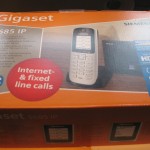
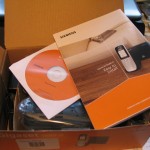
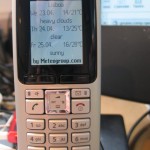
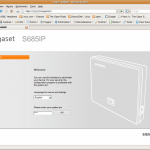
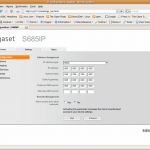
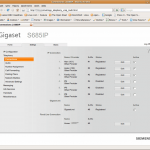
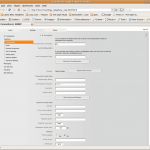
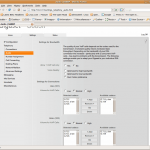
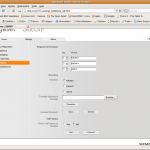
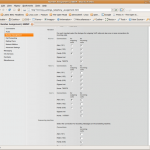
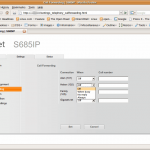
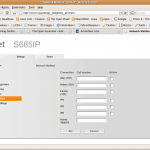
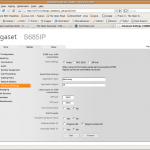
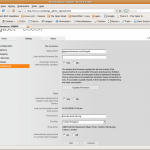



Great report on the phones. I have some older Siemens Gigaset 4000, 3000 & 2000 connected to my trixbox using SPA 3000 ATA’s. The 685IP looks like it has some great features but all of ywhat you want can be done using asterix (or other derivative). Multiple VOIP accounts with DID’s, call routing, time conditions etc etc.
I think the 685IP is a hardware alternative to using asterix, but can also be used in conjunction. The IM functionality looks really cool so would love to update my jandsets to something newer.
Cheers Andrew
Headsup for people running with more than a few users:
The S685ip base station although allowing up to 6 providers and registration of up to 6 phones, can only handle 2 sip based conversations and 1 landline conversation at a time – therefore you will need to consider the likelihood of how many simultaneous calls would be required. With this caveat in mind I have just purchased 2 basestations with 4 handsets to ensure no blocking. BUT also be aware that Siemens have confirmed that although each handset can be registered to more than one basestation, calls cannot be transferred internally from one handset to another if the handsets are registered on different base stations – which is a shame, as the internal transferring works well.
Why is this a particular headache for me? Answer: I am using asterisk as the main phone system both for our own use and also for a client. I have found issues with getting blind transfer or attended transfer via asterisk to work reliably (to get round the multiple base station issue). I seems as if the basestation/handset is not always responding to the dtmf tones; I have also had issues with handsets becoming unreliable in huntgroup/ringgroup situations e.g. yesterday one by one by client’s main extensions all start to fail to respond to inbound calls(no ringing on handset) – a reboot of each of the basestations seems to have resolved that for now.
Distinctive ring – not sure whether this model supports it – an original C46 siemens handset I have on our system has issues if it is used i.e. the other two aastra phones continue to ring (although not actually with a d. ring) but the C46 on the same hunt group fails to respond and asterisk believe the extension to be busy or unavailable – I have seen someone else with the same issue that reports that this is due to the phone not handling the d.ring signal correctly and making the phone crash or temp. unresponsive. I have simply removed the d.ring from the huntgroup and all is back to normal.
I shall continue to persevere – but would be interested if anyone else has suffered from similar issues or in particular resolved the asterisk transfer problem.
Regards Paul.
I love this phone, but I just today had a big problem with it. Our phone line was cut off accidentally and with it, obviously the DSL. The Polycom is now back up but the Siemens is acting funny.
It is currently responding to pings after a reset, both handsets have been registered. They show the latest RSS item so it has connectivity. I can’t get the telephoney page to respond on the browser while other pages show up. I’m now trying to update firmware and it’s just hourglass frozen, just as it was for the telephony page.
Randy,
Many thanks for input on Livebox. Do you mean that if the voip side of the Gigaset is connected to the Livebox then there is no dialtone? I have googled endlessly about this and it seems nobody has succeeded in using the Gigaset with Orange (or is keeping quiet about it!). I am waiting for a call from Provu on the matter but will probably buy a Gigaset anyway and dump the livebox when the contract expires. Shame though – Orange have a really good 24/7 Voip for an extra £2pm. My wife calls Germany 1hr every day for free.
barry
Alan,
Thanks for your input.
Barry
Barry,
I think I must have explained my self poorly, sorry. What I meant was that if you connect a phone to the line (at least here in France on Orange) it will not work. If you connect a phone to the Livebox, it probably will.
We have two lines coming in to our home/office:
1 copper pair normal line
1 Orange line with 8 meg Internet and unlimited dialing in France
Unfortunately, France Télécom disconnected both of these last week by mistake. My copper pair is up with our independent DSL provider. Orange number had never worked since we moved.
r
Randy,
Its not that bad in the UK! Non-ip dect phones will plug into my Livebox with no problems. All I want to achieve is to have 1 cordless dect pstn/voip phone to handle my incoming PSTN calls and my outgoing Livebox voip calls. The s685ip seemed ideal but I guess Orange have managed to block such an arrangement. I have recently asked Orange and Siemens if the Livebox/Gigaset combo will work but they give the usual get lost answers. Shame – there are millions of Livebox router/modems. Orange France are releasing a newer small version soon – hopefully less restrictive.
Barry
PS In case refuse to add another
Alan,
First of all I want to thank you for your information. Because I have configured my Siemens S685 IP to work with one landline and two VoIP-accounts I could understand your information about setting this up quite well. Nevertheless I still have some questions about this. Because I have never used Asterisk I do not yet understand too well how all the IP’s, ports, accounts and VoIP-servers all work together.
To be more specific I would like to know when a configuration will lead to conflicts.
– Can two handsets handle a phonecall to two different VoIP-providers when both VoIP-accounts use the same ports?
– What would happen if two handsets are trying to use the same VoIP-provider for a different phone call?
I understand one can address RTP-ports in the range from 5004 to 5008 and SIP-ports in the range from 5060 to 5082.
– Is it ever neccessary to use different ports for different VoIP-accounts?
– When would one use a different port?
– When would it be necessary to use random gates and when would this be problematic?
– Can one use different portnumbers for SIP and different portnumber for RTP to realize a configuration that would allow a simutaneous use of a hardphone and a softphone on a two different IP’s that both use the same VoIP account?
A VoIP-account sometimes seems to need an autgoing proxy. In the configuration of my VoipBuster account I specified that my SIP device should automatically use nat.voiptalk.org on port 5065 whenever it needs to use one.
– When will this outgoing proxy be used?
– What are the advantages and disadvantages of setting the proxy mode like this?
– What are the advantages and disadvantages of setting the proxy mode to never use an outgoing proxy?
– What are the advantages and disadvantages of setting the proxy mode to always use an outgoing proxy?
When I make an outgoing phonecall with the SIP device (of the Siemens S685 IP) and my VoipBuster account the other party doesn’t see my Caller ID eventhough I do supply a phonenumber (with a syntax of 31201234567) in the displayname. This problem doesn’t exist when I make the call with the VoipBuster softphone. The softphone doesn’t seem to use the displayname to supply a Caller ID. Instead VoipBuster can verify a personal phone number. After verification one can set a radiobutton in front of a personal phonenumber to tell VoipBuster to use this phonenumber as a Caller ID.
– Does anybody know why the hardphone doesn’t use the diplayname as a Caller ID for the other party?
– Is there a way to set up a VoipBuster account that does present a Caller ID to the other party?
– Can any server be used as an Asterisk server or is it better to dedicate this task to a simple server?
– Are there guidelines that one can follow to avoid phone ringing problems that the use of an Asterisk server seems to be causing?
– Are these less phone ringing problems without an Asterisk server?
– Is an Asterisk server some kind of router for SIP- and RTP-traffic?
– Do I understand things right when I understand that the settings for the VoIP-provider of the VoIP-accounts are transferred from the Siemens S685 IP to the Asterisk server when an Asterisk server is used as some kind of router for SIP- and RTP-traffic?
– Will the VoIP-accounts on the Siemens S685 IP only refer to the static IP of the Asterisk server?
– What will be the domain, the proxy server, the registrar server, the STUN server and the outbound proxy of the VoIP-accounts on the Siemens S685 IP and on what ports?
– What will be the domain, the proxy server, the registrar server, the STUN server and the outbound proxy of the VoIP-accounts on the Asterisk server and on what ports?
I stuffed all of my questions together in one comment because I don’t like answers that are not coherent on different sites on the web. I hope you can deal with it all and that you can address and answer them all.
Kind regards,
Ed.
@ Ed,
Thanks for your comment. You win the “longest comment” prize 😉
I will be out for a few days now, but hopefully some others might be able to answer some of your questions. Also, I am no expert on SIP, I know it can use a range of many thousands of ports for the actual voice path hence it can be hard to get through a NATing router sometimes; one great reason to use IAX.
Thanks again,
Al
Ed, may I take a crack at this? (not waiting for answer…)
STUN server can be the same in all entries. It just tells your phone what its external IP address is. Sometimes the phone will work without STUN. Otherwise, there are know STUN servers like stun.counterpath.net or maybe your provider has a reliable one?
I’m pretty sure two handsets can call on two different voip services as once.
Asterisk: if you want to run a server, it’s usually best to have a small box with nothing else on it. If you can’t do that, asterisk itself doesn’t require a lot of power. I recommend doing some research on the web, there are a huge number of info sites about this.
The whole proxy thing is beyond my knowledge but I didn’t have to use it on any of the 6 SIP accounts I have set up.
I hope Alan and others can now fill in the blanks or correct anything wrong I just implied.
r
Randulo,
Taking a crack is no problem if the objectiv is to eliminate questions.
I don’t know if stun.voipbuster.com is reliable. I would say that one can only find out if a STUN-server is reliable by using it.
Okay, so one can use two different VoIP-accounts simultaneously. Does this mean that SIP and RTP are that robust that SIP and RTP can run on the same ports for several different VoIP-accounts?
I had a lot of questions and think a lot of blanks are left to fill in.
I have one other question. I hear people say that the Siemens S685 IP can run 6 IP-accounts, 1 landline and 1 gigaset.net connection. This latter thing isn’t clear to me. I have no gigaset.net option. As far as I can see I can only configure 6 IP and 1 landline.
– Can this be because I have the dutch version of this Siemens set of is there something I have to do before I can have a gigaset.net connection?
– Is a gigaset.net connection worth anything?
Kind regards,
Ed.
“- Is a gigaset.net connection worth anything?”
Only if you have family or friends in range of their network, in which case you can talk free as you could on numerous other platforms like Skype, FWD…
[…] his experience and Alan Lord’s earlier review I’m thinking seriously about acquiring one myself. If it works as well as they say then it […]
Hi!
I wounder if it is possible to call through the Asterisk and via the Siemens Gigaset S685 IP out to my PSTN?
That is I have a wired VOIP phone connected directly to my Asterisk to day, and I have an old Siemens Gigaset SL150 connected to my PSTN.
If it works I would be able to connect all three phones through my Asterisk and use both lines for incomming and outgoing calls from all phones.
Or do I have to buy a Linksys SPA-3102 also?
///Peter!
hello @peter,
I’m a little unclear on what you are asking. If your asterisk box can make phone calls, then the 675/685 can connect to asterisk and do anything any other phone connected to that same asterisk can do.
Does that make sense?
@Ed, I’m by no means an “expert” on SIP and stuff so many of your question I do not feel confident enough to answer. However there are a few I can have a go at:
– Can any server be used as an Asterisk server or is it better to dedicate this task to a simple server?
This really depends on your load I would think. I have Asterisk running here on a very small low-power VIA C7 server. And the box does plenty more than just Asterisk. Read my series of posts on building it for what I have done. I have no performance issues from the server at all. http://www.theopensourcerer.com/2007/09/08/untangle-asterisk-pbx-and-file-server-all-in-one/
– Are there guidelines that one can follow to avoid phone ringing problems that the use of an Asterisk server seems to be causing?
I don’t know about any ringing problems. My phones ring when they should and don’t when they shouldn’t.
– Are these less phone ringing problems without an Asterisk server?
See above.
– Is an Asterisk server some kind of router for SIP- and RTP-traffic?
Kind of. But it is much more too. It is a very comprehensive software based PBX. It runs on Linux/BSD and – with suitable hardware – can interface to analogue/fixed-line services too.
– Do I understand things right when I understand that the settings for the VoIP-provider of the VoIP-accounts are transferred from the Siemens S685 IP to the Asterisk server when an Asterisk server is used as some kind of router for SIP- and RTP-traffic?
You can do it this way yes. I have all the VOIP traffic terminated on the Asterisk server and then use it to switch calls to handsets as required. You can mix and match service termination so you don’t *have* to use Asterisk to terminate everything.
– Will the VoIP-accounts on the Siemens S685 IP only refer to the static IP of the Asterisk server? You can have some accounts on the Asterisk server and some not. The S685IP does not need Asterisk although it gives you more switching/voicemail/conferencing features if you use it.
One BIG advantage – for me at least – of using Asterisk is that I only run SIP on my local LAN (no STUN, or loads of open RTP ports on my router/firewall). Traffic from the Asterisk server our other office location and to my DID provider uses the IAX protocol which only needs one open port. I haven’t used the Gigaset service so can’t comment on that.
HTH
Alan
@Peter,
If I understand what you mean I don’t think you can *dial out* via the PSTN port on the S685IP from a device that isn’t [DECT] registered to the base station – the S865IP it isn’t a full function PBX. Asterisk is though, so if you drop an X100p or something similar into your Asterisk server then all your VOIP handsets can use it when they need to.
My setup is a little different. The PSTN line into the S685IPs at our home is used for our private/home calls only. I have a second PSTN line attached to my Asterisk server that we use (now) just for backup in case the IP service dies. My DID provider will route incoming calls to it if the IP (IAX) connection is down for more than 60secs and we can use it for outbound calls in a similar fashion.
HTH
Alan
(Alan, I hope this post isn’t inappropriate. If it is, you can delete it of course.)
The Siemens S675/685IP phones are hybrid cordless multiple-handset telephones that can connect both to the PSTN and several SIP servers at once. (But you knew that already.)
To those of you asking asterisk questions. There are many places you can learn more about asterisk and SIP. It happens that on Friday of this week we are talking about places to get this information on the VUC (click on my name above). I would like to share here two links to articles by John Todd:
http://bit.ly/johntodd1
http://bit.ly/johntodd2
Although these are outdated in the detail, they are the *best* intro to what asterisk does in general, both for voip-only and PSTN connection. John has since become Digium’s Community Manager.
The general knowledge site (often outdated or not totally accurate, but a wealth of general info): http://voip-info.org
Maybe Alan or others here have their own sites as well?
/r
Thanks for the respons, I will have to put for example an Linksys SPA-3102 to get the PSTN line in to my Asterisk, then the S685 IP is able to us the Asterisk as a SIP server and through the Asterisk.
And then the Asterisk connects PSTN through the Linksys SPA-3102.
By using a SPA-3102 I will also be able to use my old wired PSTN phones as I’ve read the spec correctly.
Thanks again!
///Peter!
@Randulo, nothing wrong with that post at all.
I’m all for sharing knowledge and information and many thanks for the links and the contributions you make.
Does anyone know where I can get a S685ip in the USA? Amazon.co.uk will only ship electronics to the UK.
thanks
-jon
@jon,
It has always astounded me that Siemens apparently made no effort to distribute the product in the USA and there is no place to order one to my knowledge. I spoke to a Siemens distributor in Berlin at AsteriskTag and he was willing to ship the units (in sufficient number) but I’ve never seen one.
I wonder if there is some DECT standard or frequency issue?
I say astounded because the USA is such a huge market and they certainly could have found ways to sell these phones there IMO.
r
There is aan issue with frequency in the US and the rest of the world.
I agree that US would probebly be a big market, but compared to the rest of the world US is still kind of small *smile*
Hi all…
I just bought a Gigaset! Does anybody know if a missed international call (say Germany) would appear in the missed call log? I am seeing missed uk nrs.
Also how can I get rid of the darned weather display (or change it to my area)?
Thanks Barry
@Barry,
The international call will show up as log as the callerid is not blocked. The weather is located in the setup menu under services” I believe. You can change what is displayed by going to http://gigaset.net as described on the settings page. Right now, RSS feed, weather and biorhythms are available. If you choose an RSS feed, the title of the latest item is displayed on the phone. This is especially handy if you can concoct your own feeds. I use it to see the title of the latest post on my wife’s blog.
r
randulo, many thanks for that.
My German mother-in-law just did a missed call test for me. When ringing I saw displayed. However, in the calls list it simply says . She just has a bog standard corded phone and wouldn’t know how to block CallerID. So I’m thinking non-uk numbers are auto-blocked.
barry
randulo, many thanks for that.
resent! lt/gt chracters hide words…
My German mother-in-law just did a missed call test for me. When ringing I saw ‘INTERNATIONAL’ displayed. However, in the calls list it simply says ‘unavailable’. She just has a bog standard corded phone and wouldn’t know how to block CallerID. So I’m thinking non-uk numbers are auto-blocked.
barry
@Barry: I strongly suspect that the issue is that your mother-in-law’s telecoms provider is not forwarding the callerid information through to your telecoms provider. Your provider knows that the call originates from a foreign network, but doesn’t know any more than that. So, they can provide the “international”, but not a number that can be captured in the log. This was common back in the early days of UK mobile providers too, but they’ve pretty much got their act sorted out these days.
Hi All,
I bought a set of these phones and love them. Still need to setup with a VoIP provider though.
I do have a small problem in that when I first setup the phones, I got the weather forecast showing on the screensaver but now it has gone and I just get the clock. I have rechecked the gigaset wepsite where you set it up and also the base unit web portal.
Any ideas anyone?
Hi Ian,
I had the same, for quite some time the weather forecast was not shown. Then when my 2yo didn’t want to give it back, she pressed the off button (and loads of others) a couple of times, and when I finally had it back it showed the weather…
No, for obvious reasons you cannot borrow my daughter, but yes, you can send your phone over for the same treatment.
Otherwise, just try (and it’s not that I didn’t try before – it is in the manual – to the point where the phone switches off..) and try again.
Another remark: I just found out that you have to use the ‘Name:’ setting with your fixed line number in international format to get CID / Caller ID working when you call others (not the ‘Display name:’- setting) with justvoip.com (and likely voipbuster / voipwise / voipraider etc who all use the same backbone afaik).. Something I really needed to make the wife happy, she didn’t like that others would get ‘unknown caller’ all the time.
Hope this helps.
Thanks for that Rob, I will try it when I get home, I too have a daughter but she is older (17), when I give her a phone she usually runs up a bill, at least on the mobile ! Watch pout for that one.
You can have her for free but she has high maintenance costs 🙂
Ian
Hi SixedUp,
Thanks for the info – will try to explain to mum in law and get her to ring her telecom co to get caller id allowed.
Barry
Rob wrote:
Another remark: I just found out that you have to use the ‘Name:’ setting with your fixed line number in international format to get CID / Caller ID working when you call others (not the ‘Display name:’- setting) with justvoip.com (and likely voipbuster / voipwise / voipraider etc who all use the same backbone afaik)..
Thanks Rob, this works fine in my setup now too and it solved one of the things I brought up earlier. Because I haven’t got a VoIP-In number I’m sending the number of my landline instead. This works fine, but some confusement might be a consequence.
B.T.W. Because I want to concentrate on other things I won’t be reading this thread anymore. I might still read it some months later. I’m still interested in the matter, but just can’t cope with it all at the moment.
Hi,
Can anyone tell me if the Siemns 685IP will work with a WIFI network i.e. unplugged. My routers are outside of the house – will the Siemens pick up a WIFI signal?
Thanks,
Fred.
@Fred.
I don’t think so no. The Base station has a LAN (RJ45 port). I’m pretty sure it doesn’t have WiFi built in.
Perhaps you could buy a small RJ45 ethernet to WiFi dongle or something?
Hi,
Thanks for the suggestion. That sounds like a solution, but can anyone suggest a suitable dongle/adapter. I take it that I would need a Ethernet RJ45 male to USB female connector, so that I could plug in a male WIFI stick??
Thanks,
Fred
@Fred,
a quick Google threw up something like this: http://reviews.cnet.com/networking-and-wi-fi/netgear-me101-wireless-ethernet/4505-3243_7-30485209.html
Do some digging and I’m sure there will be several devices that would do the job.
Why thank you – that looks to be the sort of device I need.
Regards,
Fred
I’m thinking of investing in the S685 IP – great article btw. Does anyone know the main differences between this and the C475 IP which is a bit cheaper.
Had a look on google and found it a bit cheaper here – seems to be lots of good reviews too
http://www.cordless-phones.uk.com/voip-phones/voip-dect-phones/siemens-gigaset-s685ip-twin
Emailed Siemens but no reply yet. Any help appreciated.
Thanks!
Hi James, thanks for commenting.
If I recall correctly there are a few benefits the 685 has over the older C475.
* High definition wide-band codec support (Sounds AWESOME between compatible handsets)
* ECODect mode (Uses less power and creates less radiation)
* Bluetooth support (for headsets etc)
* Smaller more “professional” style handset???
HTH
Alan
Hi
I bought a S685IP after trying all sorts of Mobiles (SMC TigerVoip Ut Starcom 1000 crap.. ).
I was very happy until the first FW Update. Now i am loosing Calls (not all calls go throu)
Especially if you are using 1line it may happen that nobody can call on the second.
I am aditionally using the bluetooth with my jabra headset. The phone just locks up and it takes ages to get a calling notice on my headset.
because of the base ignoring my calls i now got a snom m3. In my opinion: if you do not need bluetooth and fancy weather but you want to be able to MUTE and transfer, conference calls invest in a snom!
way faster phone! Much better call lists. And they are able to show name and number in the call lists.
Whilst the Snom looks nice, it is IP only whereas I need both PSTN and IP which the Siemens does.
Nice writeup. I bought one myself today, and so far I’m impressed! Cheers Ferg
Hello
Can these be used with BT Talk.
Thanks in advance.
@Jeff,
Hi there, I am not familiar with BT Talk. If the IP interface it offers is a standard SIP protocol then I can’t see why it shouldn’t.
Try googling for “BT Talk” + SIP or something similar… Here’s the first post I came across. It looks promising…
HTH
Alan
Jeff,
I have an Orange Livebox and both Siemens and Orange were unhelpful re: working with Gigaset. I bought the phone anyway and am very pleased with it. So much so that I will dump the Livebox when my contract expires!
I would be extemely interested in your experience with BT talk if you go ahead. Please keep us posted!
Barry
To all the people with siemens handsets who get these NOTIFY errors in the asterisk server message log add the following stanza to sip.conf and the messages will disappear.
subscribemwi=yes
View bug report here:
http://bugs.digium.com/view.php?id=12560
The reason for this bug:
http://www.voip-info.org/wiki/index.php?page_id=4615&tk=ad72fd8e03fc48451c55&comments_page=1
I just got a mail from Siemens:
Das Gigaset S675IP akzeptiert (RFC-konform) nur SIP-Notify Messages die auch vorher via Subscribe-Message angefordert wurden.
Die meisten übrigen SIP-Telefone am Markt akzeptieren jede (auch nicht-subscribte) Messages. Asterisk unterstützt erst ab Version 1.4 SIP MWI-Subscriptions.
Prüfen Sie bitte, ob Sie eine Asterisk Version > 1.4 nutzen.
In english it means that the S675IP only take SIP-Notify Messages wich are requested before. Asterisk > 1.4 uses the SIP MWI-Subscriptions.
I hope this information helps.
@Mike,
Thanks for the input. Although I have set the mwi thingy to on. I will check it all later. But just to confirm, should this be set in the [general] section or for each sip device entry?
Cheers
Alan
I’m having real problems with the S658s and Asterisk (1.4.22).
I assume the problem is with the base though, not Asterisk.
I have 2x bases; one with 5 phones and another with 3. They phones de-register themselves from Asterisk randomly making the SIP channel unreachable. Not using NAT.
I’ve seen similar (and read on here) problems from other users and referred to http://www.siemens-gigaset-forum.com/de/posts/list/13788.page where others have support calls open.
Siemens support were rather unhelpful (check my router etc when the Asterisk box is on the LAN!). I have unfortunately drawn a blank as I can only attribute the issue to firmware on the base (have updated to latest available as of Jan 09 – 021400000000 / 043.00).
Anyone else experiencing similar problems? Or successes?
Can anyone recommend a stable working DECT SIP phone for enterprise use?
Many thanks.
@Simon,
it’s interesting. About two weeks ago, I noticed that our phones had stopped working. A bit of digging and I noticed that they had become de-registered. This was the first (and only) time this has occured since they were installed back in April last year. I put ot down to the fact that my server had been locking up randomly rather than the phones themselves. I’ve kept the S685 updated whenever the handset notified me.
My asterisk server is running 1.4.13 and, again, has basically been rock solid since it was started. So I can’t help you with any fixes, but perhaps you could look at asterisk versions as well as possible Siemens issues?
The Snom M3 looks nice and has a good reputation, but for me it wasn’t helpful as it does not have a PSTN port. We use our S685s for home/office and having both interfaces is a required feature for us. Our phones and my asterisk server have basically been on 24/7 since April last year with the only problem being my server (a Jetway VIA C7 low power device) occasionally locking up. But I think this is down to h/w plus kernel revision incompatibilities. Shortly I plan to upgrade the linux on my server – I may *not* update asterisk….
HTH
Alan
Oops; just to clarify, each phone has its own unique SIP account on our internal Asterisk server. Kind regards.